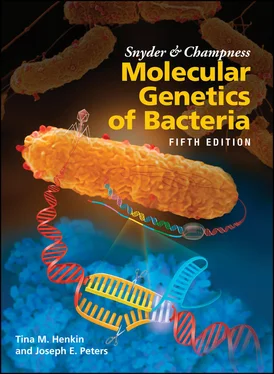612 614
613 615
614 616
About the Companion Website
This book is accompanied by a companion website:
The URL is www.wiley.com/go/snyder/mgb5 
The website includes:
Figures from the book
Snyder & Champness Molecular Genetics of Bacteria
FIFTH EDITION
Tina M. Henkin
Ohio State University, Columbus, Ohio
Joseph E. Peters
Cornell University, Ithaca, New York

Copyright © 2020 American Society for Microbiology. All rights reserved.
Copublication by the American Society for Microbiology and John Wiley & Sons, Inc. No part of this publication may be reproduced, stored in a retrieval system, or transmitted in any form or by any means electronic, mechanical, photocopying, recording, scanning, or otherwise, except as permitted by law. Advice on how to reuse material from this title is available at http://wiley.com/go/permissions.
The right of Tina M. Henkin and Joseph E. Peters to be identified as the authors of this work has been asserted in accordance with law.
Limit of Liability/Disclaimer of Warranty
While the publisher and author have used their best efforts in preparing this book, they make no representations or warranties with respect to the accuracy or completeness of the contents of this book and specifically disclaim any implied warranties or merchantability or fitness for a particular purpose. No warranty may be created or extended by sales representatives or written sales materials. The publisher is not providing legal, medical, or other professional services. Any reference herein to any specific commercial products, procedures, or services by trade name, trademark, manufacturer, or otherwise does not constitute or imply endorsement, recommendation, or favored status by the American Society for Microbiology (ASM). The views and opinions of the author(s) expressed in this publication do not necessarily state or reflect those of ASM, and they shall not be used to advertise or endorse any product.
Editorial Correspondence: ASM Press, 1752 N Street, NW, Washington, DC 20036-2904, USA
Registered Offices: John Wiley & Sons, Inc., 111 River Street, Hoboken, NJ 07030, USA
For details of our global editorial offices, customer services, and more information about Wiley products, visit us at www.wiley.com.
Wiley also publishes its books in a variety of electronic formats and by print-on-demand. Some content that appears in standard print versions of this book may not be available in other formats.
Library of Congress Cataloging-in-Publication Data
Names: Henkin, Tina M., author. | Peters, Joseph E., author. Molecular genetics of bacteria.
Title: Snyder & Champness molecular genetics of bacteria / Tina M. Henkin, Ohio State University, Columbus, Ohio, Joseph E. Peters, Cornell University, Ithaca, New York.
Other titles: Molecular genetics of bacteria
Description: Fifth edition. | Hoboken, NJ : John Wiley & Sons, Inc.; Washington, D.C. : American Society for Microbiology, [2020] | Series: ASM books | Revised edition of: Molecular genetics of bacteria / Larry Snyder … [et al.]. 4th ed. c2013. | Includes bibliographical references and index.
Identifiers: LCCN 2020001847 (print) | LCCN 2020001848 (ebook) | ISBN 9781555819750 (hardback) | ISBN 9781555819767 (adobe pdf) | ISBN 9781683673576 (epub)
Subjects: LCSH: Bacterial genetics. | Bacteriophages—Genetics. | Molecular genetics.
Classification: LCC QH434 .S59 2020 (print) | LCC QH434 (ebook) | DDC 579.3/135—dc23
LC record available at https://lccn.loc.gov/2020001847
LC ebook record available at https://lccn.loc.gov/2020001848
Cover images:
Illustration: © 2017 Terese Winslow LLC
Micrograph: Scanning electron micrograph of adsorption of phage JWAlpha to Achromobacter DSM 11852 cells. From Wittmann J, Dreiseikelmann B, Rohde M, et al., Virology 11:14 (2014), https://www.ncbi.nlm.nih.gov/pmc/articles/PMC3915230/, CC-BY 2.0
Authors: Henkin, courtesy Ohio State University; Peters, courtesy Jay N. Worley
Cover and interior design: Susan Brown Schmidler
Snyder and Champness Molecular Genetics of Bacteria is a new edition of a classic text updated to address the massive advances in the field of bacterial molecular genetics. We renamed the book as a tribute to the original authors, Larry Snyder and Wendy Champness, who welcomed us as coauthors for the 4th edition and trusted us to continue to build on the strong foundation of their multiple editions in carrying this important text forward. As with the previous editions, we have endeavored to keep the page length approximately the same. This meant making many hard choices of what to remove to make room for exciting new and important material. We are very happy that every illustration is now in full color, which offered us the opportunity to rethink each drawing and clarify and standardize features, which we believe will improve their use by instructors in classroom lectures.
Perhaps the most significant force in molecular genetics research since the last edition has been the plummeting cost of DNA sequencing. This factor has created an explosion of new sequence information of both independent genomes and microbial communities in the form of metagenomics, where DNA is extracted directly from all of the organisms in an environment. This information has vastly expanded our picture of the tree of life and the massive contribution of uncultured species. The broader availability of DNA sequencing at a reasonable price has also left its mark on genomic techniques. These new techniques and new information have had a considerable impact in every chapter and provided the impetus for a new chapter, “Genomes and Genomic Analysis” ( chapter 13).
We expanded chapter 1, on DNA structure, DNA replication, and chromosome segregation, to include many advances in our understanding of how chromosomes are managed and the molecular machines that carry out these processes. Our understanding of the nature of FtsK and related DNA-pumping enzymes, the evolving role of SeqA, the mechanism of chromosome partitioning, and the domain structure of the chromosomes also benefited from multiple technological innovations. Chapter 2focuses on mechanisms of gene expression, from transcription through mRNA turnover, translation, and post-translational effects, including protein targeting, which was moved into this chapter. We reduced the historical aspects of chapter 3, retaining key landmarks such as the important role of the F plasmid discovered by Esther Lederberg, so the chapter now focuses more on practical aspects of genetic analysis. Newer molecular techniques that have replaced some of the classic approaches (e.g., for generation of targeted chromosomal mutations) are now discussed in the new chapter 13.
Chapter 4presents a concise understanding of bacterial plasmids as important contributors to the genomic content in bacteria as well as essential tools in molecular biology. Significant additions to the chapter include an expanded discussion of the two major mechanisms of segregation and the ever-broadening view of toxin-antitoxin systems. Toxin-antitoxin systems were first discovered for their role in plasmid stabilization, but while the diversity of molecular mechanisms has expanded, important questions remain concerning the real function of these systems when situated in bacterial chromosomes. Chapter 5, which focuses on conjugation, continues to set its roots in the original conjugal plasmid, the fertility plasmid. We included considerable new information that relates to our recognition that conjugal systems appear to be as common in the form of integrating conjugative elements (ICEs) as they are in stand-alone plasmids. The diversity of ICEs is remarkable, and this chapter strives to provide a foundation for these dynamic elements, which are responsible for the largest known genomic islands transmitted between bacteria.
Читать дальше













